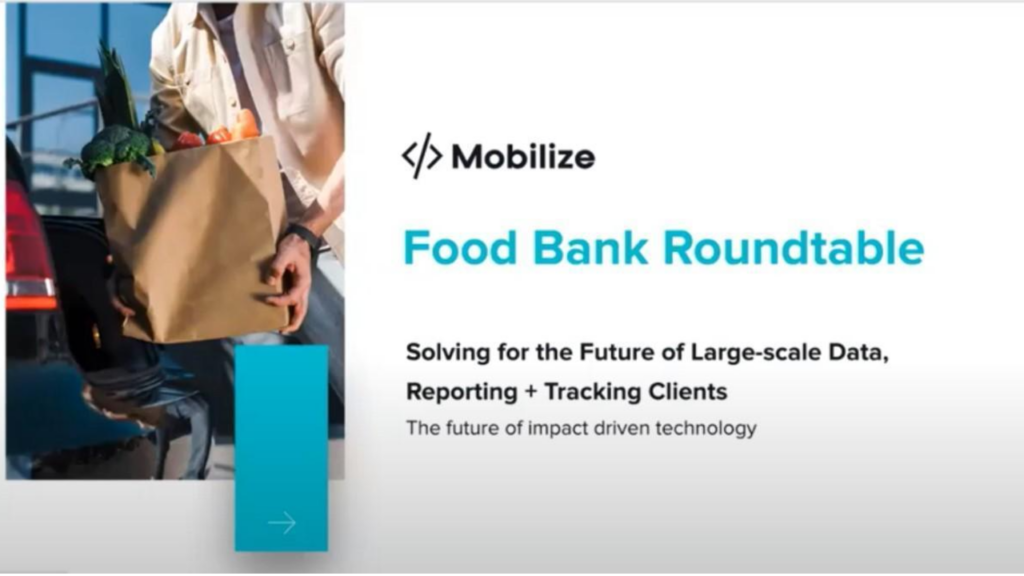5 Lessons We Learned From Mobilize’s Food Bank Roundtable
Food banks are willing to adopt new communications solutions to meet their clients’ needs. They want solutions that bridge the gap between their organizations and community members, ensuring both parties can seamlessly engage with one another at any time.
Furthermore, food banks want solutions that create new access points and allow them to navigate big-picture data. These solutions will empower food banks to serve their communities better and take a step forward in their quest to end global hunger.
Here’s a look at what food banks can accomplish with Mobilize’s data collection + SMS platform.
Mobilize is committed to helping end hunger in the United States. In order to gain insight directly from the industry, we recently hosted a roundtable with several food bank leaders to learn what they would like the future of food distribution to look like.
Our roundtable gave us a glimpse into how food banks use technology to engage with their communities. It also provided us with insights into how our platform can help them enhance communication with their communities and drive engagement.
Here are five lessons we learned from Mobilize’s food bank roundtable.
-
The COVID-19 pandemic created a “new normal” for food banks — and they need to engage with community members accordingly.
No organization is immune to the “new normal” of the pandemic. For food banks, the pandemic has highlighted the importance of using accessible technology to connect with those in need.
By implementing simple digital workflows, food banks keep both their team and the people they serve safer and make their services more accessible. For example, today food banks are using Mobilize’s platform to let people apply for services from anywhere, eliminating the need for folks to call in or visit the food bank to apply for services. Some food banks have implemented a service where people can text INTAKE to a local food bank’s dedicated toll-free number and be sent a link to an intake form. Or, when someone texts FOOD to a food bank’s dedicated toll-free number, they can receive a link to its website or a location and hours.
SMS messaging empowers food banks to instantly deliver text updates to large groups of people. In doing so, it has helped food banks let people know if food is available at different sites across the United States during the pandemic.
-
Using a centralized system and improving the user experience are top priorities.
Data collection automation workflows can make a world of difference for food banks, too. Food banks can use these workflows to automate mobile surveys. These surveys allow food banks to learn about their communities with minimal time or resources required. This lets food banks reallocate the time and resources that would be used setting up mobile surveys to reviewing their results and finding better ways to respond to the needs of the community. This could allow food banks to discover opportunities to engage community members like never before.
A centralized system that simultaneously makes it simple to reach customers and keep end-user data safe is key for food banks. With this system, anyone can quickly and easily sign up for SMS notifications from food banks and receive these updates on their mobile devices. Plus, the system continuously stores and protects user data while giving food banks opportunities to use this information to share details about the types of food they need.
Food banks are continuously exploring ways to improve the user experience, as well. The ability to deliver a user-friendly experience empowers food banks to consistently provide their communities with timely, relevant, and accurate information. It also ensures that community members feel engaged — to the point where they work together to support food banks and one another in combating hunger in the United States.
-
Food banks have access to a wealth of data — and they need to make the most of this information.
Food banks must gather a variety of data using a wide range of apps and tools, but they typically don’t work together. This can create redundancies, particularly when it comes to entering client data. Ultimately, food banks need tech that can be integrated into their existing systems. For this reason, Mobilize created an API that lets food banks collect and analyze data and send messages using their existing systems. It comes with pre-built Zapier connections, so it ensures our platform can be integrated into a variety of tools right away, with a team ready to create integrations for a variety of tools.
Food banks also rely on data from the U.S. Census, community services, and other sources. The volume of data available is significant, but they may be missing out on opportunities to get the most value out of it.
Every food bank has its own client database. Yet, food banks rarely share that data with one another or any other social service organization. There is an unfulfilled need for tech that gives food banks and other social service organizations both the big picture to watch trends in their areas and individual data to better serve clientele.
-
Tech can help food banks improve the client experience.
Today’s always-on, always-connected consumers want a seamless experience when they shop for groceries or any other items. Some food banks want to bring this experience to their clientele. To do so, they are exploring ways to replicate the grocery store shopping experience and take it to the next level.
Consumers can visit grocery stores in person or online and pick out any items they’d like. Now, food banks are considering ways to provide clients with shopping experiences more similar to commercial solutions. The future of food banks lies in technology that gives clients food choice and multiple forms of distribution, including delivery.
-
Sharing data can lead to better food bank services and better results.
Although food banks collect data, they rarely share it with one another. As food banks get better at managing and securing data, they may be more likely to share it with other food banks and local agencies. This would lead to better outcomes for food banks and their clients.
Food banks need a centralized data repository that lets them track and manage data in real-time. This repository must also be secure and user-friendly. That way, food banks can access data, gain insights from it, and use it to find ways to continuously improve their services.
Data sharing can help food banks identify trends and provide better services. For example, a client can agree to let a food bank share their information with other local agencies. And, if the client qualifies for any services that these agencies offer, they could be notified.
Mobilize serves the needs of food banks and their clients
At Mobilize, we strive to help food banks and their clients in any way we can. Our food bank roundtable provided us with a valuable learning opportunity. We intend to take what we’ve learned from the roundtable and use it to find ways to further enhance our SMS messaging platform.
Food banks can use Mobilize’s platform to simplify text communications and data collection with their clients. Our platform enables food banks to provide text updates to hundreds or thousands of people in seconds. It also allows them to collect and analyze community member data, send mobile surveys and questionnaires, and more.
We encourage food banks to reach out to learn more about our platform, how it works, and its benefits. Contact us today to get started or take a look at our plans and pricing.


